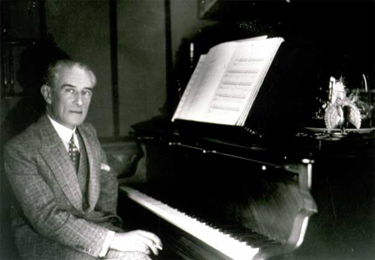Maurice Ravel (1875-1937)
Born March 7, 1875, in Ciboure, Basses-Pyrenees.
Died December 28, 1937 in Paris.
La Valse, une poème choréographique
Composed in 1919-1920.
First Orchestral Performance: December 12, 1920 with Camille Chevillard conducting the Lamoureux Orchestra of Paris.
Instrumentation: 2 flutes, piccolo, 2 oboes, English horn, 2 clarinets, bass clarinet, 2 bassoons, contrabassoon, 4 horns, 3 trumpets, 3 trombones, tuba, timpani, triangle, tambourine, snare drum, bass drum, cymbals, castanets, tam tam, wood blocks, crotales, 2 harps, and strings.
Around 1906, Ravel began to write a tribute to Johann Strauss entitled Wien(Vienna) that he described as, “. . . a kind of apotheosis of the Viennese waltz, with which is associated in my imagination an impression of a fantastic and fatal kind of Dervish’s dance.” [1] Health problems and war intervened and prevented Ravel from finishing the composition. At the request of the impresario Sergei Diaghilev, Ravel resumed work on the piece in 1919, but by that time Vienna was a ghost of her former self, reflected magically in the music. When the work was completed in 1920, Diaghilev refused to stage it. The Paris dance premiere of [amazon text=La Valse&asin=B000001GPI] in 1928 was by Rubenstein who also gave the premiere of [amazon text=Boléro&asin=B000001GLO] two days later.
The score bears a brief scenic description: “Through whirling clouds can be glimpsed now and again waltzing couples. The mists gradually disperse, and at letter A (in the score) a huge ballroom is revealed filled with a great crowd of whirling dancers. The stage grows gradually lighter. At the fortissimo at letter B the lights in the chandeliers are turned full on. The scene is an imperial palace about 1855.”
Ravel portrays the opening “mist” with a very quiet tremolo on the basses with the rest of the strings playing muted bowing over the fingerboard. Over the mist, fragmentary bits of a waltz are peeking through on the woodwinds. At letter A, when the ballroom is in focus, the music is still very soft. A waltz theme is more fully revealed by the violas, which are countered by the woodwinds. It is not until letter B – when the chandeliers are at the height of brightness – that the entire orchestra plays a fortissimo cadence in D major followed by a fully formed waltz played by a solo oboe.

What follows is a series of waltzes in two sections. The second section presents no new thematic material and leads into a “fatal Dervish whirling.”
[1] Rollo Myers. Ravel: Life and Works
Resources
[amazon template=iframe image&asin=B000001GPI][amazon template=iframe image&asin=B000001GLO]
[amazon template=iframe image&asin=0486259625][amazon template=iframe image&asin=0486295915][amazon template=iframe image&asin=0486441873]
